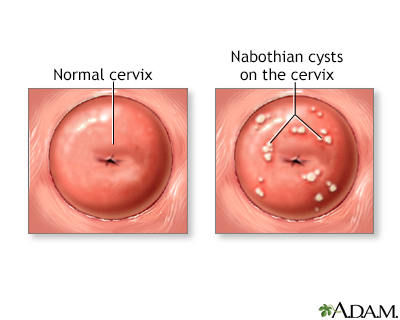Nabothian cyst
Definition
A nabothian cyst is a lump filled with mucus on the surface of the cervix or cervical canal.
The cervix is located at the lower end of the womb (uterus) at the top of the vagina. It is about 1 inch (2.5 centimeters) long.
Causes
The cervix is lined with glands and cells that release mucus. The glands can become covered by a type of skin cells called squamous epithelium. When this happens, the secretions build up in the plugged glands. They form a smooth, rounded bump on the cervix. The bump is called a nabothian cyst.
Symptoms
Each nabothian cyst appears as a small, white raised bump. There can be more than one.
Exams and Tests
During a pelvic exam, the health care provider will see a small, smooth, rounded lump (or collection of lumps) on the surface of the cervix. Rarely, magnifying the area (colposcopy) may be needed to tell these cysts from other bumps that can occur.
Most women have small nabothian cysts. These can be detected by vaginal ultrasound. If you're told you have a nabothian cyst during a vaginal ultrasound exam, don't be concerned, as their presence is normal.
Sometimes the cyst is opened to confirm the diagnosis.
Treatment
No treatment is necessary. Nabothian cysts do not cause any problems.
Outlook (Prognosis)
Nabothian cysts do not cause any harm. They are a benign condition.
Possible Complications
The presence of many cysts or cysts that are large and blocked can make it hard for the provider to do a Pap test. This is rare.
When to Contact a Medical Professional
Most of the time, this condition is found during a routine pelvic exam.
Prevention
There is no known prevention.
Gallery

References
Baggish MS. Anatomy of the cervix. In: Baggish MS, Karram MM, eds. Atlas of Pelvic Anatomy and Gynecologic Surgery. 5th ed. Philadelphia, PA: Elsevier; 2021:chap 42.
Choby BA. Cervical polyps. In: Fowler GC, eds. Pfenninger and Fowler's Procedures for Primary Care. 4th ed. Philadelphia, PA: Elsevier; 2020:chap 123.
Dolan MS, Hill CC, Valea FA. Benign gynecologic lesions: vulva, vagina, cervix, uterus, oviduct, ovary, ultrasound imaging of pelvic structures. In: Gershenson DM, Lentz GM, Valea FA, Lobo RA, eds. Comprehensive Gynecology. 8th ed. Philadelphia, PA: Elsevier; 2022:chap 18.
Mendiratta V, Lentz GM. History, physical examination, and preventive health care. In: Gershenson DM, Lentz GM, Valea FA, Lobo RA, eds. Comprehensive Gynecology. 8th ed. Philadelphia, PA: Elsevier; 2022:chap 7.